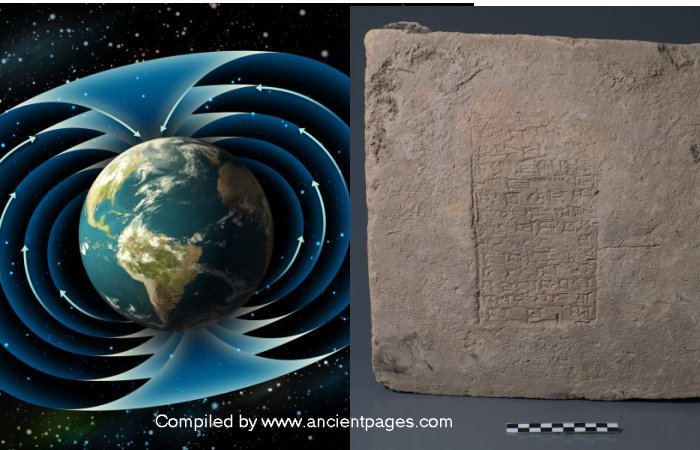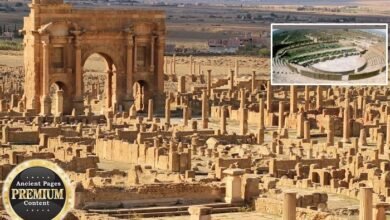Mysterious Anomaly In Earth’s Magnetic Field Documented On 3,000-Year-Old Mesopotamian Bricks

Jan Bartek – AncientPages.com – During previous excavations, archaeologists have found plenty of evidence that Babylonians and Sumerians were skilled astronomers.
Sumerian cuneiform tablets confirm that knowledge of the Sumerians was not limited only to the knowledge of our solar system. People in Mesopotamia observed the night sky with great interest. They wanted and documented the positions and movements of stars, planets, asteroids, and any other celestial body they could spot. A recent study published in the Proceedings of the National Academy of Sciences reveals ancient Mesopotamians had great interest in the strength of Earth’s ancient magnetic field.
Earth magnetic field. Credit: Adobe Stock – Andrea Danti
Scientists from the University College London have examined ancient bricks inscribed with the names of Mesopotamian kings and discovered they yield important insights into a mysterious anomaly in Earth’s magnetic field 3,000 years ago.
The published study describes how changes in the Earth’s magnetic field were imprinted on iron oxide grains within ancient clay bricks and how scientists could reconstruct these changes from the names of the kings inscribed on the bricks.
The team hopes that using this “archaeomagnetism,” which looks for signatures of the Earth’s magnetic field in archaeological items, will improve the history of Earth’s magnetic field and can help better date artifacts that they previously couldn’t.
“We often depend on dating methods such as radiocarbon dates to get a sense of chronology in ancient Mesopotamia. However, some of the most common cultural remains, such as bricks and ceramics, cannot typically be easily dated because they don’t contain organic material. This work now helps create an important dating baseline that allows others to benefit from absolute dating using archaeomagnetism,” Co-author Professor Mark Altaweel (UCL Institute of Archaeology) said.
The Earth’s magnetic field weakens and strengthens over time, changes which imprint a distinct signature on hot minerals that are sensitive to the magnetic field.
The team analyzed the latent magnetic signature in grains of iron oxide minerals embedded in 32 clay bricks originating from archaeological sites throughout Mesopotamia, which now overlaps with modern day Iraq. The strength of the planet’s magnetic field was imprinted upon the minerals when they were first fired by the brickmakers thousands of years ago.
At the time they were made, each brick was inscribed with the name of the reigning king which archaeologists have dated to a range of likely timespans. Together, the imprinted name and the measured magnetic strength of the iron oxide grains offered a historical map of the changes to the strength of the Earth’s magnetic field.
The researchers were able to confirm the existence of the “Levantine Iron Age geomagnetic Anomaly,” a period when Earth’s magnetic field was unusually strong around modern Iraq between about 1050 to 550 B.C. for unclear reasons. Evidence of the anomaly has been detected as far away as China, Bulgaria and the Azores, but data from within the southern part of the Middle East itself had been sparse.
“By comparing ancient artifacts to what we know about ancient conditions of the magnetic field, we can estimate the dates of any artifacts that were heated up in ancient times,” Lead author Professor Matthew Howland of Wichita State University said.
To measure the iron oxide grains, the team carefully chipped tiny fragments from broken faces of the bricks and used a magnetometer to precisely measure the fragments.
By mapping out the changes in Earth’s magnetic field over time, this data also offers archaeologists a new tool to help date some ancient artifacts. The magnetic strength of iron oxide grains embedded within fired items can be measured and then matched up to the known strengths of Earth’s historic magnetic field. The reigns of kings lasted from years to decades, which offers better resolution than radiocarbon dating which only pinpoints an artifact’s date to within a few hundred years.
Brick dates to the reign of Nebuchadnezzar II (ca. 604 to 562 BCE) based on the interpretation of the inscription. This object was looted from its original context before being acquired by the Slemani Museum and stored in that museum with agreement from the central government. Image courtesy of the Slemani Museum. Credit: Slemani Museum
An additional benefit of the archaeomagnetic dating of the artifacts is it can help historians more precisely pinpoint the reigns of some of the ancient kings that have been somewhat ambiguous. Though the length and order of their reigns is well known, there has been disagreement within the archaeological community about the precise years they took the throne resulting from incomplete historical records. The researchers found that their technique lined up with an understanding of the kings’ reigns known to archaeologists as the “Low Chronology.”
The team also found that in five of their samples, taken during the reign of Nebuchadnezzar II from 604 to 562 BCE, the Earth’s magnetic field seemed to change dramatically over a relatively short period of time, adding evidence to the hypothesis that rapid spikes in intensity are possible.
“The geomagnetic field is one of the most enigmatic phenomena in Earth sciences. The well-dated archaeological remains of the rich Mesopotamian cultures, especially bricks inscribed with names of specific kings, provide an unprecedented opportunity to study changes in the field strength in high time resolution, tracking changes that occurred over several decades or even less,” co-author Professor Lisa Tauxe of the Scripps Institution of Oceanography said.
The study was published in the journal Proceedings of the National Academy of Sciences
Written by Jan Bartek – AncientPages.com Staff Writer






